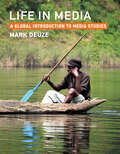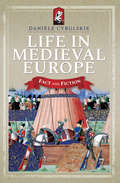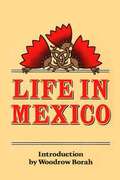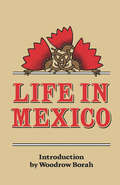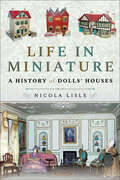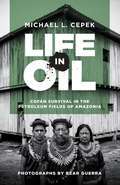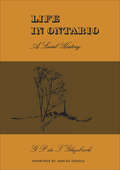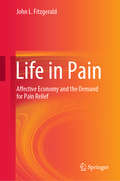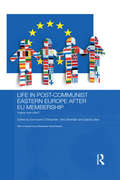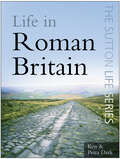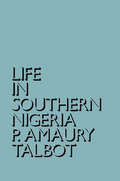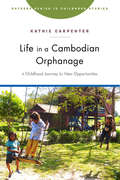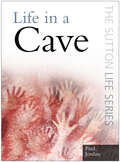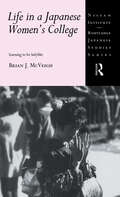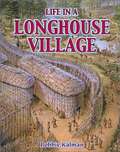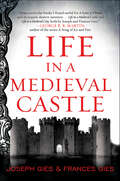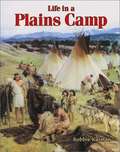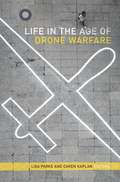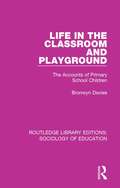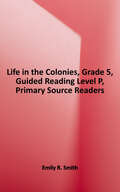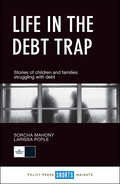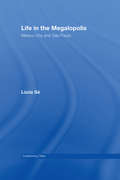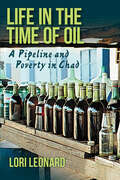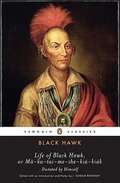- Table View
- List View
Life in Media: A Global Introduction to Media Studies
by Mark DeuzeA new way to teach media studies that centers students&’ lived experiences and diverse perspectives from around the world.From the intimate to the mundane, most aspects of our lives—how we learn, love, work, and play—take place in media. Taking an expansive, global perspective, this introductory textbook covers what it means to live in, rather than with, media. Mark Deuze focuses on the lived experience—how people who use smartphones, the internet, and television sets make sense of their digital environment—to investigate the broader role of media in society and everyday life. Life in Media uses relatable examples and case studies from around the world to illustrate the foundational theories, concepts, and methods of media studies. The book is structured around six core themes: how media inform and inspire our daily activities; how we live our lives in the public eye; how we make distinctions between real and fake; how we seek and express love; how we use media to effect change; how we create media and shared narratives; and how we seek to create well-being within media. By deliberately including diverse voices and radically embracing the everyday and mundane aspects of media life, this book innovates ways to teach and talk about media.Highlights diverse international voices, images, and casesUses accessible examples from everyday life to contextualize theory Offers a comprehensive, student-centered introduction to media studiesExtensively annotated bibliography offers dynamic sources for further study, including readings and documentary films
Life in Medieval Europe: Fact and Fiction
by Danièle Cybulskie&“A lovely, witty treasure trove of a book, spilling over with historical gems . . . a very human history: sometimes weird, always wonderful.&” —Dan Jones, New York Times-bestselling author Have you ever found yourself watching a show or reading a novel and wondering what life was really like in the Middle Ages? What did people actually eat? Were they really filthy? And did they ever get to marry for love? In Life in Medieval Europe: Fact and Fiction, you&’ll find fast and fun answers to all your secret questions, from eating and drinking to sex and love. Find out whether people bathed, what they did when they got sick, and what actually happened to people accused of crimes. Learn about medieval table manners, tournaments, and toothpaste, and find out if people really did poop in the moat. &“To say that this book was fun to read would be an understatement. Cybulskie&’s knowledge radiates in every page of this short book . . . It was educational and entertaining all at the same time. Simply a wonderful resource for novice medievalists and writers of historical fiction and nonfiction alike.&” —Adventures of a Tudor Nerd &“All in all, this is an excellent book to put to bed many of the myths surrounding medieval existence that persist in the popular imagination. Easy to read and well worth the time to read it. I highly recommend this book if you want to get a mostly unbiased view of medieval life.&” —Battles and Book Reviews
Life in Mexico
by Frances Calderón de la BarcaThis book contains observations made during a two years' residence in Mexico, by Frances Calderón de la Barca, whose position there made her intimately acquainted with its society, and opened to her the best sources of information in regard to whatever could interest an enlightened foreigner. Also, it consists of letters written to the members of her family.
Life in Mexico
by Frances Calderón de la Barca Woodrow BorahThis is a pre-1923 historical reproduction that was curated for quality. Quality assurance was conducted on each of these books in an attempt to remove books with imperfections introduced by the digitization process. Though we have made best efforts - the books may have occasional errors that do not impede the reading experience. We believe this work is culturally important and have elected to bring the book back into print as part of our continuing commitment to the preservation of printed works worldwide.
Life in Miniature: A History of Dolls' Houses
by Nicola LisleA “comprehensive and enjoyable” guide to the centuries-long history of dolls’ houses and how they illuminate our past (Books Monthly).Dolls’ houses are tiny slices of social history that give us a fascinating glimpse into domestic life over the last three hundred years. Through text and photos, Nicola Lisle explores the origins and history of dolls’ houses and their furnishings, from the earliest known dolls’ house in sixteenth-century Bavaria to the present, and looks at how they reflect the architecture, fashions, social attitudes, innovations, and craftsmanship of their day. She discusses the changing role of dolls’ houses and highlights significant events and people to give historical context, as well as taking a look at some of the leading dolls’ house manufacturers such as Silber & Fleming and Lines Brothers Ltd (later Triang).Included are numerous examples of interesting dolls’ houses, the stories behind them, and where to see them—including famous models such as Queen Mary’s spectacular 1920s dolls’ house at Windsor Castle. There is also a chapter on model towns and villages, which became popular in the twentieth century and also give us a window on the past by replicating real places or capturing scenes typical of a bygone era, plus advice for dolls’ house collectors, a detailed directory of places to visit, a timeline of dolls’ house history, and recommended further reading.
Life in Oil: Cofán Survival in the Petroleum Fields of Amazonia
by Michael L. CepekOil is one of the world’s most important commodities, but few people know how its extraction affects the residents of petroleum-producing regions. Life in Oil presents the compelling, nuanced story of how the Cofán manage to endure at the center of Ecuadorian petroleum extraction. In this book, the author Michael L. Cepek goes well beyond popular and academic accounts of their suffering to share the largely unknown stories that Cofán people themselves create--the ones they tell in their own language, in their own communities, and to one another and the few outsiders they know and trust. Their words reveal that life in oil is a form of slow, confusing violence for some of the earth’s most marginalized, yet resilient, inhabitants.
Life in Ontario: A Social History
by G.P, deT. GlazebrookThis is Ontario's story, a collective biography of her people, a history of her development as a province. Illustrated by Adrian Dingle, this refreshing study, with its emphasis on the personal, offers an enduring portrait of a province.
Life in Pain: Affective Economy and the Demand for Pain Relief
by John L. FitzgeraldThis book explores pain in a number of ways. At the heart of the book is an extension of Melzack’s neuromatrix theory of pain into the social, cultural, and economic fields. Specific assemblages involving varied institutions, flows of capital, encounters, and social and economic structures provide a framework for the formation of pain, its perception, experience, meaning, and cultural production. Complementing the extended neuromatrix is a second theory, focussed on the propensity of western market capitalism to seek out new areas of life to subsume to capital. Pain is one such life area that is now ripe for exploitation. Although the book has theory at its heart, it draws extensively on case studies to identify the contradictions and complexities. Case studies are drawn from accounts of drug use in varied contexts such as prescription drugs, methamphetamine use, oxycodone use in North America, and the global rise of the medicinal cannabis marketplace.
Life in Post-Communist Eastern Europe after EU Membership: Happy Ever After? (Routledge Contemporary Russia And Eastern Europe Ser.)
by Donnacha Ó Beacháin Vera Sheridan Sabina StanThis book examines how membership of the European Union has affected life in the ten former communist countries of Eastern Europe that are now members of the European Union. For each country, political, economic and social changes are described and discussed, together with people’s perceptions of the effects of EU membership. Overall, the book shows how the benefits of EU membership have differed between different countries, and how perceptions about the benefits also differ and have changed over time.
Life in Roman Britain: The Sutton Life Series
by Joan P. AlcockThe authoritative and accessible look at life in Roman Britain begins with a brief overview of the province in its historical context. The book then concentrates on the social history of the 400 years of Roman occupation with thematically arranged chapters on fucisign on administration; life in the army; religion; recreation; housing; food and drink; personal lifestyle; and art and decoration. Drawing on both the latest archaeological evidence and testimony from classical writers. the author recreates the lifestyles of those who lived in this part of a once great empire. With over 100 illustrations of sites, artefacts and reconstructions, and a comprehensive further reading section, this book will appeal to anyone interested in the Roman Period in Britain.
Life in Southern Nigeria: The Magic, Beliefs and Customs of the Ibibio Tribe
by Percy Amaury TalbotThis work describes the beliefs, customs and traditions of this tribe from the Ekat district.
Life in a Cambodian Orphanage: A Childhood Journey for New Opportunities (Rutgers Series in Childhood Studies)
by Kathie CarpenterWhat is it like to grow up in an orphanage? What do residents themselves have to say about their experiences? Are there ways that orphanages can be designed to meet children's developmental needs and to provide them with necessities they are unable to receive in their home communities? In this book, detailed observations of children's daily life in a Cambodian orphanage are combined with follow-up interviews of the same children after they have grown and left the orphanage. Their thoughtful reflections show that the quality of care children receive is more important for their well-being than the site in which they receive it. Life in a Cambodian Orphanage situates orphanages within the social and political history of Cambodia, and shows that orphanages need not always be considered bleak sites of deprivation and despair. It suggests best practices for caring for vulnerable children regardless of the setting in which they are living.
Life in a Cave
by Paul JordanWhat was it like to be a caveman? What sort of house would you live in? What sort of clothes would you wear? Paul Jordan takes us back in time to see what it was really like to live in prehistoric times, what kind of animals we would have shared the land with, and what our daily life would involve. How would you have managed in this strange and difficult world?
Life in a Japanese Women's College: Learning to be Ladylike (Nissan Institute/Routledge Japanese Studies)
by Brian J. McVeighOne third of the Japanese female workforce are 'office ladies' and their training takes place in the many women's junior colleges. Office ladies are low-wage, low-status secretaries who have little or no job security.Brian J. McVeigh draws on his experience as a teacher at one such institution to explore the cultural and social processes used to promote 'femininity' in Japanese women. His detailed and ethnographically-informed study considers how the students of these institutions are socialized to fit their future dual roles of employees and mothers, and illuminates the sociopolitical role that the colleges play in Japanese society as a whole.
Life in a Longhouse Village
by Bobbie KalmanLearn about life in a longhouse village. Topics include how a longhouse was built, clan life, gifts from the land, and the roles of men, women, children and elders.
Life in a Medieval Castle (Medieval Life)
by Frances Gies Joseph GiesThe definitive classic used as a source for Game of Thrones: “The Gieses succeed in making a remote and unfamiliar world accessible.” —Kirkus ReviewsA bestseller by two widely respected historians, Joseph and Frances Gies’s Life in a Medieval Castle remains a timeless work of popular medieval scholarship.Focusing on Chepstow, an English castle on the Welsh border that survived the turbulent Middle Ages with a relative lack of violence, the book offers an exquisite portrait of what day-to-day life was actually like during the era, and of the key role the castle played. The Gieses take us through the full cycle of a medieval year, dictated by the rhythms of the harvest. We learn what lords and serfs alike would have worn, eaten, and done for leisure—and of the outside threats the castle strove to keep at bay.“The authors allow medieval man and woman to speak for themselves through selections from past journals, songs, even account books.” —TimeIncludes photographs and maps
Life in a Plains Camp
by Bobbie KalmanThis book talks about the life of native Americans who lived in the Great Plains region -- their clothing, food, shelter and other interesting facts about their lifestyle.
Life in the Age of Drone Warfare
by Caren Kaplan Lisa ParksThis volume's contributors offer a new critical language through which to explore and assess the historical, juridical, geopolitical, and cultural dimensions of drone technology and warfare. They show how drones generate particular ways of visualizing the spaces and targets of war while acting as tools to exercise state power. Essays include discussions of the legal justifications of extrajudicial killings and how US drone strikes in the Horn of Africa impact life on the ground, as well as a personal narrative of a former drone operator. The contributors also explore drone warfare in relation to sovereignty, governance, and social difference; provide accounts of the relationships between drone technologies and modes of perception and mediation; and theorize drones’ relation to biopolitics, robotics, automation, and art. Interdisciplinary and timely, Life in the Age of Drone Warfare extends the critical study of drones while expanding the public discussion of one of our era's most ubiquitous instruments of war. Contributors. Peter Asaro, Brandon Wayne Bryant, Katherine Chandler, Jordan Crandall, Ricardo Dominguez, Derek Gregory, Inderpal Grewal, Lisa Hajjar, Caren Kaplan, Andrea Miller, Anjali Nath, Jeremy Packer, Lisa Parks, Joshua Reeves, Thomas Stubblefield, Madiha Tahir
Life in the Classroom and Playground: The Accounts of Primary School Children (Routledge Library Editions: Sociology of Education #17)
by Bronwyn DaviesThis study, first published in 1982, approaches children from an ethogenic viewpoint. It records their own accounts of their social world and sees them as members of a distinct culture with its own perspective, code of behaviour and strategies for making sense of their lives. The author suggests that teachers who can take the pupil’s perspective into account will work together more successfully with these pupils in the process of communicating their adult knowledge to the children. This title will be of interest to students of sociology and education.
Life in the Colonies (Primary Source Readers)
by Emily R. SmithYoung readers will be fascinated to learn what life was like for the colonists in early America. The detailed images and easy-to-read text explore such topics as Puritans, the Mayflower Compact, House of Burgesses, the Navigation Acts, and slavery. <p><p>Along with brief biographies on colonists and Indians like John Smith, William Penn, Pocahontas, and John Rolfe, this engaging reader explains the means of survival and living through farming, colonial crops, and plantations. A table of contents and glossary are provided to enhance readers' understanding of the content and vocabulary.
Life in the Debt Trap: Stories of Children and Families Struggling with Debt
by Sorcha Mahony Larissa PopleWhat is life like for families who are stuck in problem debt? Why do they fall into a spiral of debt in the first place, and why is it so hard to escape? The first hand stories in this book offer a unique understanding of life for families and children fighting a daily battle against poverty and debt. They give voice to some of the most underrepresented people in society, who are too often portrayed cruelly in the media and elsewhere. Drawing on research data collected through The Children’s Society’s Debt Trap campaign, this book explores the causes, implications and impacts of problem debt, challenges pejorative public attitudes and encourages more compassionate policy making to help families escape poverty and debt.
Life in the Himalaya: An Ecosystem at Risk
by Maharaj K. PanditThe collision of the Indian and Eurasian plates 50 million years ago created the Himalaya, along with massive glaciers, intensified monsoon, turbulent rivers, and an efflorescence of ecosystems. Today, the Himalaya is at risk of catastrophic loss of life. Maharaj Pandit outlines the mountain’s past in order to map a way toward a sustainable future.
Life in the Megalopolis: Mexico City and Sao Paulo (Questioning Cities)
by Lucia SaThe modern metropolis has been called 'the symbol of our times', and life in it epitomizes, for many, modernity itself. But what to make of inherited ideas of modernity when faced with life in Mexico City and São Paulo, two of the largest metropolises in the world? Is their fractured reality, their brutal social contrasts, and the ever-escalating violence faced by their citizens just an intensification of what Engels described in the first in-depth analysis of an industrial metropolis, nineteenth century Manchester? Or have post-industrial and neo-globalized economies given rise to new forms of urban existence in the so-called developing world? Life in the Megalopolis: Mexico City and São Paulo investigates how such questions are explored in cultural productions from these two Latin American megalopolises, the focus being on literature, film popular music, and visual arts. This book combines close readings of works with a constant reference to theoretical, anthropological and social studies of these two cities, and builds on received definitions of the concept megalopolis Life in the Megalopolis is the first book to combine urban-studies theories (particularly Lefebvre, Harvey, and de Certeau) with Benjaminian cultural analyses, and theoretical discussions with close-readings of recent cultural works in various media. It is also the first book to compare Mexico City and São Paulo.
Life in the Time of Oil: A Pipeline And Poverty In Chad
by Lori LeonardLife in the Time of Oil examines the Chad-Cameroon Petroleum Development and Pipeline Project--a partnership between global oil companies, the World Bank, and the Chadian government that was an ambitious scheme to reduce poverty in one of the poorest countries on the African continent. Key to the project was the development of a marginal set of oilfields that had only recently attracted the interest of global oil companies who were pressed to expand operations in the context of declining reserves. Drawing on more than a decade of work in Chad, Lori Leonard shows how environmental standards, grievance mechanisms, community consultation sessions, and other model policies smoothed the way for oil production, but ultimately contributed to the unraveling of the project. Leonard offers a nuanced account of the effects of the project on everyday life and the local ecology of the oilfield region as she explores the resulting tangle of ethics, expectations, and effects of oil as development.
Life of Black Hawk, or Ma-ka-tai-me-she-kia-kiak
by Black HawkA controversial figure in his day, Black Hawk was the leader of the Sauk American Indian tribe in the early 1800s. The son of the tribe s medicine man, Black Hawk s exploits as a warrior aided his rise to the status of tribal war leader. Here, Black Hawk chronicles his life as well as the story of his tribe, who were forced from their lands in Illinois during a series of skirmishes with American settlers in what came to be known as the Black Hawk War.
